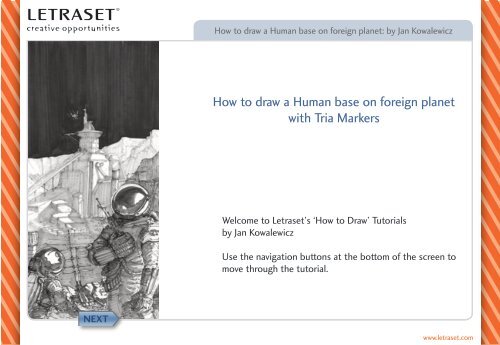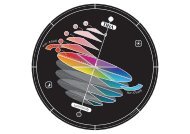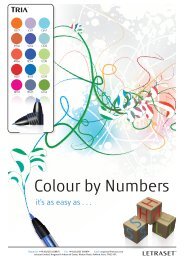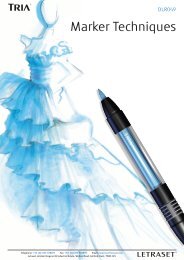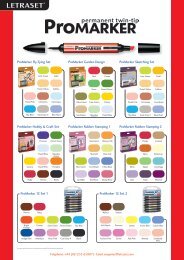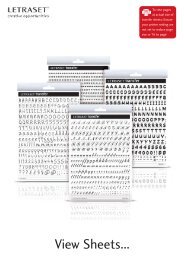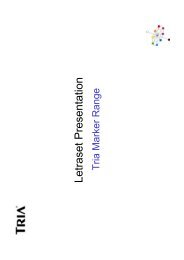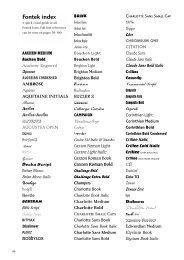How to draw a Human base on foreign planet with Tria ... - Letraset
How to draw a Human base on foreign planet with Tria ... - Letraset
How to draw a Human base on foreign planet with Tria ... - Letraset
You also want an ePaper? Increase the reach of your titles
YUMPU automatically turns print PDFs into web optimized ePapers that Google loves.
<str<strong>on</strong>g>How</str<strong>on</strong>g> <str<strong>on</strong>g>to</str<strong>on</strong>g> <str<strong>on</strong>g>draw</str<strong>on</strong>g> a <str<strong>on</strong>g>Human</str<strong>on</strong>g> <str<strong>on</strong>g>base</str<strong>on</strong>g> <strong>on</strong> <strong>foreign</strong> <strong>planet</strong>: by Jan Kowalewicz<br />
<str<strong>on</strong>g>How</str<strong>on</strong>g> <str<strong>on</strong>g>to</str<strong>on</strong>g> <str<strong>on</strong>g>draw</str<strong>on</strong>g> a <str<strong>on</strong>g>Human</str<strong>on</strong>g> <str<strong>on</strong>g>base</str<strong>on</strong>g> <strong>on</strong> <strong>foreign</strong> <strong>planet</strong><br />
<strong>with</strong> <strong>Tria</strong> Markers<br />
Welcome <str<strong>on</strong>g>to</str<strong>on</strong>g> <strong>Letraset</strong>’s ‘<str<strong>on</strong>g>How</str<strong>on</strong>g> <str<strong>on</strong>g>to</str<strong>on</strong>g> Draw’ Tu<str<strong>on</strong>g>to</str<strong>on</strong>g>rials<br />
by Jan Kowalewicz<br />
Use the navigati<strong>on</strong> but<str<strong>on</strong>g>to</str<strong>on</strong>g>ns at the bot<str<strong>on</strong>g>to</str<strong>on</strong>g>m of the screen <str<strong>on</strong>g>to</str<strong>on</strong>g><br />
move through the tu<str<strong>on</strong>g>to</str<strong>on</strong>g>rial.<br />
www.letraset.com
<str<strong>on</strong>g>How</str<strong>on</strong>g> <str<strong>on</strong>g>to</str<strong>on</strong>g> <str<strong>on</strong>g>draw</str<strong>on</strong>g> a <str<strong>on</strong>g>Human</str<strong>on</strong>g> <str<strong>on</strong>g>base</str<strong>on</strong>g> <strong>on</strong> <strong>foreign</strong> <strong>planet</strong>: by Jan Kowalewicz<br />
A general note.<br />
We divide the process of <str<strong>on</strong>g>draw</str<strong>on</strong>g>ing in<str<strong>on</strong>g>to</str<strong>on</strong>g> three phases. The first phase<br />
is <str<strong>on</strong>g>draw</str<strong>on</strong>g>ing everything linearly. In this phase we decide where all the<br />
objects are, we set the compositi<strong>on</strong>, the frame and the centre of the<br />
<str<strong>on</strong>g>draw</str<strong>on</strong>g>ing. The sec<strong>on</strong>d phase covers making all the details, the third<br />
– the shadows. <str<strong>on</strong>g>How</str<strong>on</strong>g>ever, in case of <str<strong>on</strong>g>draw</str<strong>on</strong>g>ing as complicated picture<br />
as shown above, we d<strong>on</strong>’t stick <str<strong>on</strong>g>to</str<strong>on</strong>g> this process <str<strong>on</strong>g>to</str<strong>on</strong>g>o accurately, after<br />
the linear phase is <str<strong>on</strong>g>draw</str<strong>on</strong>g>n. It is because <str<strong>on</strong>g>draw</str<strong>on</strong>g>ing such a wide variety of<br />
things is hard <str<strong>on</strong>g>to</str<strong>on</strong>g> plan and, in fact, it is not necessary <str<strong>on</strong>g>to</str<strong>on</strong>g> do so.<br />
<str<strong>on</strong>g>How</str<strong>on</strong>g>ever, when we plan a <str<strong>on</strong>g>draw</str<strong>on</strong>g>ing, we have <str<strong>on</strong>g>to</str<strong>on</strong>g> remember about a few<br />
features which are significant for a good compositi<strong>on</strong>. These are:<br />
light, c<strong>on</strong>trasts and air space.<br />
www.letraset.com
<str<strong>on</strong>g>How</str<strong>on</strong>g> <str<strong>on</strong>g>to</str<strong>on</strong>g> <str<strong>on</strong>g>draw</str<strong>on</strong>g> a <str<strong>on</strong>g>Human</str<strong>on</strong>g> <str<strong>on</strong>g>base</str<strong>on</strong>g> <strong>on</strong> <strong>foreign</strong> <strong>planet</strong>: by Jan Kowalewicz<br />
A general note.<br />
Light.<br />
We have <str<strong>on</strong>g>to</str<strong>on</strong>g> think where the source of the light is. We never <str<strong>on</strong>g>draw</str<strong>on</strong>g> objects<br />
al<strong>on</strong>g the line of the light. In such a case the picture becomes flat and<br />
lacks of depth. In the picture it is c<strong>on</strong>trastive and full of deep shadow<br />
because of the diverted terrain. Except the situati<strong>on</strong> when we <str<strong>on</strong>g>draw</str<strong>on</strong>g><br />
against the light, <strong>on</strong>e side of the picture is always in deep shadow while<br />
the opposite is in a glare.<br />
Air space<br />
To show the envir<strong>on</strong>ment of the <strong>planet</strong> we have<br />
<str<strong>on</strong>g>to</str<strong>on</strong>g> set wide view frame. We do this by setting<br />
the horiz<strong>on</strong>tal line higher then the average and<br />
by placing the <str<strong>on</strong>g>base</str<strong>on</strong>g> in the crater or a valley. It is<br />
important <str<strong>on</strong>g>to</str<strong>on</strong>g> show many different ground secti<strong>on</strong>s<br />
as well as harshness of the alien-terrain.<br />
C<strong>on</strong>trasts<br />
C<strong>on</strong>trasts in the picture give the observer dynamism and tensi<strong>on</strong>.<br />
Moreover, c<strong>on</strong>trasted objects look str<strong>on</strong>ger. For example we use such<br />
c<strong>on</strong>trasts as:<br />
- openwork – solid<br />
- horiz<strong>on</strong>tal – vertical – diag<strong>on</strong>al<br />
- dark - light<br />
- sharp – smooth (texture of objects)<br />
- heights – depressi<strong>on</strong>s<br />
www.letraset.com
<str<strong>on</strong>g>How</str<strong>on</strong>g> <str<strong>on</strong>g>to</str<strong>on</strong>g> <str<strong>on</strong>g>draw</str<strong>on</strong>g> a <str<strong>on</strong>g>Human</str<strong>on</strong>g> <str<strong>on</strong>g>base</str<strong>on</strong>g> <strong>on</strong> <strong>foreign</strong> <strong>planet</strong>: by Jan Kowalewicz<br />
The first phase.<br />
Because <str<strong>on</strong>g>draw</str<strong>on</strong>g>ing by markers is a wet and transparent technique we<br />
generally saturate the picture from the lightest <str<strong>on</strong>g>to</str<strong>on</strong>g> the darkest hues.<br />
The picture below is <str<strong>on</strong>g>draw</str<strong>on</strong>g>n by CG 09 <strong>Tria</strong> Markers.<br />
The first stage of <str<strong>on</strong>g>draw</str<strong>on</strong>g>ing includes:<br />
1: a line of the horiz<strong>on</strong><br />
2: lines of mountains<br />
3: a draft of all main objects<br />
Pic.01. The first step – set the horiz<strong>on</strong> line and the compositi<strong>on</strong>; CG 09 <strong>Tria</strong> Markers.<br />
www.letraset.com
<str<strong>on</strong>g>How</str<strong>on</strong>g> <str<strong>on</strong>g>to</str<strong>on</strong>g> <str<strong>on</strong>g>draw</str<strong>on</strong>g> a <str<strong>on</strong>g>Human</str<strong>on</strong>g> <str<strong>on</strong>g>base</str<strong>on</strong>g> <strong>on</strong> <strong>foreign</strong> <strong>planet</strong>: by Jan Kowalewicz<br />
The first phase.<br />
If we are <str<strong>on</strong>g>to</str<strong>on</strong>g> <str<strong>on</strong>g>draw</str<strong>on</strong>g> any scenery or a landscape, it is crucial <str<strong>on</strong>g>to</str<strong>on</strong>g> start <strong>with</strong><br />
the horiz<strong>on</strong> line (pic.01). In case of the horiz<strong>on</strong>tal frame, we usually<br />
<str<strong>on</strong>g>draw</str<strong>on</strong>g> the line in 1/3 of the paper sheet. The higher you <str<strong>on</strong>g>draw</str<strong>on</strong>g> the<br />
line, the more of the terrain you have <str<strong>on</strong>g>to</str<strong>on</strong>g> fill <strong>with</strong> rocks, plants etc.<br />
Because of the specific envir<strong>on</strong>ment of <strong>foreign</strong> <strong>planet</strong> it is reas<strong>on</strong>able<br />
<str<strong>on</strong>g>to</str<strong>on</strong>g> <str<strong>on</strong>g>draw</str<strong>on</strong>g> the line a bit higher. That gives us opportunity <str<strong>on</strong>g>to</str<strong>on</strong>g> show the<br />
differences between the Earth and the <strong>planet</strong>.<br />
Pic. 02. C<strong>on</strong>trast of horiz<strong>on</strong>tal and vertical lines<br />
The picture is <str<strong>on</strong>g>draw</str<strong>on</strong>g>n as if the observer would be standing <strong>on</strong> the<br />
hill, next <str<strong>on</strong>g>to</str<strong>on</strong>g> the astr<strong>on</strong>auts. In case of this picture, the horiz<strong>on</strong> line<br />
goes through any object that is <strong>on</strong> the same level as an observer.<br />
Everything what is above this line is higher than the observer;<br />
everything that is below – is smaller or lower.<br />
As it was menti<strong>on</strong>ed above, it is important <str<strong>on</strong>g>to</str<strong>on</strong>g> put in<str<strong>on</strong>g>to</str<strong>on</strong>g> the<br />
compositi<strong>on</strong> many c<strong>on</strong>trasts. In the picture adjacent (pic. 02.) the<br />
horiz<strong>on</strong>tal and vertical lines are given.<br />
www.letraset.com
<str<strong>on</strong>g>How</str<strong>on</strong>g> <str<strong>on</strong>g>to</str<strong>on</strong>g> <str<strong>on</strong>g>draw</str<strong>on</strong>g> a <str<strong>on</strong>g>Human</str<strong>on</strong>g> <str<strong>on</strong>g>base</str<strong>on</strong>g> <strong>on</strong> <strong>foreign</strong> <strong>planet</strong>: by Jan Kowalewicz<br />
The first phase.<br />
Moreover, the next picture (pic. 03.) shows c<strong>on</strong>trasts of heights and<br />
depressi<strong>on</strong>s both in foreground and in the background.<br />
Those c<strong>on</strong>trasts give us a feeling of a str<strong>on</strong>g tensi<strong>on</strong> in a<br />
compositi<strong>on</strong>. These effects will be strengthened by the c<strong>on</strong>trasts of<br />
light.<br />
Pic. 03. C<strong>on</strong>trast of heights and depressi<strong>on</strong>s<br />
www.letraset.com
<str<strong>on</strong>g>How</str<strong>on</strong>g> <str<strong>on</strong>g>to</str<strong>on</strong>g> <str<strong>on</strong>g>draw</str<strong>on</strong>g> a <str<strong>on</strong>g>Human</str<strong>on</strong>g> <str<strong>on</strong>g>base</str<strong>on</strong>g> <strong>on</strong> <strong>foreign</strong> <strong>planet</strong>: by Jan Kowalewicz<br />
The first phase.<br />
In further process of saturati<strong>on</strong> we get further c<strong>on</strong>trasts – light and<br />
textures of the materials. As it was menti<strong>on</strong>ed above, linear <str<strong>on</strong>g>draw</str<strong>on</strong>g>ing<br />
has <str<strong>on</strong>g>to</str<strong>on</strong>g> be finished before the details and the shadows are given.<br />
Therefore, we saturate the picture setting more or less all the objects<br />
(pic. 04.).<br />
Pic. 04. Saturating linear <str<strong>on</strong>g>draw</str<strong>on</strong>g>ing by CG 09 and 06 markers<br />
It is important in such a theme <str<strong>on</strong>g>to</str<strong>on</strong>g> <str<strong>on</strong>g>draw</str<strong>on</strong>g> many different machines and<br />
buildings which suits the roughness of the envir<strong>on</strong>ment – vehicles,<br />
various broadcasting devices, hangars, covered roads, flying ships,<br />
fac<str<strong>on</strong>g>to</str<strong>on</strong>g>ry chimneys etc. The human figures ought <str<strong>on</strong>g>to</str<strong>on</strong>g> be equipped for<br />
space travelling <str<strong>on</strong>g>to</str<strong>on</strong>g> enhance the effect of inaccessibility and even<br />
hostility of the <strong>planet</strong>.<br />
www.letraset.com
<str<strong>on</strong>g>How</str<strong>on</strong>g> <str<strong>on</strong>g>to</str<strong>on</strong>g> <str<strong>on</strong>g>draw</str<strong>on</strong>g> a <str<strong>on</strong>g>Human</str<strong>on</strong>g> <str<strong>on</strong>g>base</str<strong>on</strong>g> <strong>on</strong> <strong>foreign</strong> <strong>planet</strong>: by Jan Kowalewicz<br />
The first phase.<br />
Just before the end of the first phase we <str<strong>on</strong>g>draw</str<strong>on</strong>g> a line (CG 02 marker)<br />
which separates sky from the rest of the picture (pic.05.).<br />
That is the end of the first phase. We have almost all the objects set.<br />
The frame and the compositi<strong>on</strong> will not change any further.<br />
Pic. 05. Separating line (CG 02).<br />
www.letraset.com
<str<strong>on</strong>g>How</str<strong>on</strong>g> <str<strong>on</strong>g>to</str<strong>on</strong>g> <str<strong>on</strong>g>draw</str<strong>on</strong>g> a <str<strong>on</strong>g>Human</str<strong>on</strong>g> <str<strong>on</strong>g>base</str<strong>on</strong>g> <strong>on</strong> <strong>foreign</strong> <strong>planet</strong>: by Jan Kowalewicz<br />
The sec<strong>on</strong>d phase.<br />
The first thing that the observer notices is that there are many<br />
things going <strong>on</strong>. There are a few space crafts, large off-road vehicle,<br />
two astr<strong>on</strong>auts setting the aerial, several chimneys exhaling fumes<br />
etc.<br />
Pic. 06. setting the centre of the picture.<br />
Therefore, the first thing we need <str<strong>on</strong>g>to</str<strong>on</strong>g> do now is making a decisi<strong>on</strong><br />
where the centre should be. It is not strict geometrical middle of the<br />
paper-sheet. <str<strong>on</strong>g>How</str<strong>on</strong>g>ever, it is near <str<strong>on</strong>g>to</str<strong>on</strong>g> it. The centre of the picture is the<br />
place where the sketch is most c<strong>on</strong>densed <strong>with</strong> lines, most <str<strong>on</strong>g>draw</str<strong>on</strong>g>n<br />
and, at last but not least, where the observer has <str<strong>on</strong>g>to</str<strong>on</strong>g> look first (pic.<br />
06.).<br />
www.letraset.com
<str<strong>on</strong>g>How</str<strong>on</strong>g> <str<strong>on</strong>g>to</str<strong>on</strong>g> <str<strong>on</strong>g>draw</str<strong>on</strong>g> a <str<strong>on</strong>g>Human</str<strong>on</strong>g> <str<strong>on</strong>g>base</str<strong>on</strong>g> <strong>on</strong> <strong>foreign</strong> <strong>planet</strong>: by Jan Kowalewicz<br />
The sec<strong>on</strong>d phase.<br />
From now <strong>on</strong>, we saturate the picture <strong>with</strong> more and more details<br />
and lines up <str<strong>on</strong>g>to</str<strong>on</strong>g> the darkest hues of colour we use according the<br />
following scheme.<br />
Pic. 07. Drawing the sky – wide tip of very wet CG 02.<br />
We start <strong>with</strong> CG 09 and CG 06 markers which we put <strong>on</strong> the whole<br />
picture <strong>with</strong> more or less the same intensity. Than we use darker and<br />
darker hues <strong>on</strong> more and more c<strong>on</strong>centrated space of the picture.<br />
Due <str<strong>on</strong>g>to</str<strong>on</strong>g> the compositi<strong>on</strong> we can distinguish three grounds – far<br />
background (mountains), middle ground (close mountains, crater)<br />
and foreground (astr<strong>on</strong>auts, vehicle and aerials). To make the<br />
<str<strong>on</strong>g>draw</str<strong>on</strong>g>ing simple and planned we divide the process of <str<strong>on</strong>g>draw</str<strong>on</strong>g>ing more<br />
or less in<str<strong>on</strong>g>to</str<strong>on</strong>g> the four stages: <str<strong>on</strong>g>draw</str<strong>on</strong>g>ing the sky, the background, the<br />
middle ground and the foreground.<br />
After the first phase (linear <str<strong>on</strong>g>draw</str<strong>on</strong>g>ing) we <str<strong>on</strong>g>draw</str<strong>on</strong>g> the dark night sky (pic.<br />
07.) using very wet CG 02 marker. To enhance the effect of hostility<br />
of the <strong>planet</strong> we do not <str<strong>on</strong>g>draw</str<strong>on</strong>g> any atmosphere so the sky is dark even<br />
at no<strong>on</strong>.<br />
www.letraset.com
<str<strong>on</strong>g>How</str<strong>on</strong>g> <str<strong>on</strong>g>to</str<strong>on</strong>g> <str<strong>on</strong>g>draw</str<strong>on</strong>g> a <str<strong>on</strong>g>Human</str<strong>on</strong>g> <str<strong>on</strong>g>base</str<strong>on</strong>g> <strong>on</strong> <strong>foreign</strong> <strong>planet</strong>: by Jan Kowalewicz<br />
The sec<strong>on</strong>d phase.<br />
For now, the sky looks a bit odd because of the strips, but we fix this<br />
later <strong>on</strong>. From now <strong>on</strong>, we <str<strong>on</strong>g>draw</str<strong>on</strong>g> the picture from the background <str<strong>on</strong>g>to</str<strong>on</strong>g><br />
the foreground. We do it in that manner <str<strong>on</strong>g>to</str<strong>on</strong>g> avoid the mess which<br />
would occur in case of <str<strong>on</strong>g>draw</str<strong>on</strong>g>ing such complicated picture hue by hue.<br />
Therefore, we <str<strong>on</strong>g>draw</str<strong>on</strong>g> the far background mountains using CG 06 for<br />
details and shadow <strong>on</strong> the right firstly, and CG 09 for their surfaces<br />
(pic. 08) sec<strong>on</strong>dly. This sequences of marker usage smooths out the<br />
c<strong>on</strong>trast of hues what is important in the far background objects.<br />
Pic. 08. Drawing and saturating the far background mountains – CG 06 and CG 09<br />
As we can see in the picture below, it is possible <str<strong>on</strong>g>to</str<strong>on</strong>g> add few elements<br />
<str<strong>on</strong>g>to</str<strong>on</strong>g> the compositi<strong>on</strong>. This fact shows us that whatever we <str<strong>on</strong>g>draw</str<strong>on</strong>g> using<br />
CG09 marker it may be over<str<strong>on</strong>g>draw</str<strong>on</strong>g>n <strong>with</strong> darker hues and disappear.<br />
www.letraset.com
<str<strong>on</strong>g>How</str<strong>on</strong>g> <str<strong>on</strong>g>to</str<strong>on</strong>g> <str<strong>on</strong>g>draw</str<strong>on</strong>g> a <str<strong>on</strong>g>Human</str<strong>on</strong>g> <str<strong>on</strong>g>base</str<strong>on</strong>g> <strong>on</strong> <strong>foreign</strong> <strong>planet</strong>: by Jan Kowalewicz<br />
The sec<strong>on</strong>d phase.<br />
The next thing we <str<strong>on</strong>g>draw</str<strong>on</strong>g> is the middle ground (pic. 09.). We add<br />
details and shadows using CG 04 marker while CG 06 is used for<br />
smoothing out the surfaces of the mountains and buildings. At<br />
this stage, the CG 04 marker is also used <str<strong>on</strong>g>to</str<strong>on</strong>g> bring out few details<br />
<str<strong>on</strong>g>to</str<strong>on</strong>g> the foreground. It is also used <str<strong>on</strong>g>to</str<strong>on</strong>g> give shadow <str<strong>on</strong>g>to</str<strong>on</strong>g> the figures of<br />
astr<strong>on</strong>auts <str<strong>on</strong>g>to</str<strong>on</strong>g> set the light in it. It is important <str<strong>on</strong>g>to</str<strong>on</strong>g> do so, because we<br />
can easily over<str<strong>on</strong>g>draw</str<strong>on</strong>g> some places in the foreground unintenti<strong>on</strong>ally,<br />
that are <str<strong>on</strong>g>to</str<strong>on</strong>g> be left white and shiny.<br />
Pic. 09. Drawing and saturating the middle ground mountains CG 06 and 04.<br />
www.letraset.com
<str<strong>on</strong>g>How</str<strong>on</strong>g> <str<strong>on</strong>g>to</str<strong>on</strong>g> <str<strong>on</strong>g>draw</str<strong>on</strong>g> a <str<strong>on</strong>g>Human</str<strong>on</strong>g> <str<strong>on</strong>g>base</str<strong>on</strong>g> <strong>on</strong> <strong>foreign</strong> <strong>planet</strong>: by Jan Kowalewicz<br />
The sec<strong>on</strong>d phase.<br />
It is the time <str<strong>on</strong>g>to</str<strong>on</strong>g> <str<strong>on</strong>g>draw</str<strong>on</strong>g> the main shades and shadows as well as<br />
saturate the closer middle ground (pic.10.). To give a str<strong>on</strong>g tensi<strong>on</strong><br />
and atmosphere of the harsh envir<strong>on</strong>ment, we <str<strong>on</strong>g>draw</str<strong>on</strong>g> l<strong>on</strong>g shades from<br />
the mountains <strong>on</strong> the right.<br />
Pic. 10. Shadows and shades; details of closer middle ground; CG 04 marker<br />
www.letraset.com
<str<strong>on</strong>g>How</str<strong>on</strong>g> <str<strong>on</strong>g>to</str<strong>on</strong>g> <str<strong>on</strong>g>draw</str<strong>on</strong>g> a <str<strong>on</strong>g>Human</str<strong>on</strong>g> <str<strong>on</strong>g>base</str<strong>on</strong>g> <strong>on</strong> <strong>foreign</strong> <strong>planet</strong>: by Jan Kowalewicz<br />
The sec<strong>on</strong>d phase.<br />
The background and almost whole middle ground is now finished. As<br />
we can see above, there are fumes coming out of the chimneys and<br />
jets of the space crafts. This effect is achieved by taking advantage<br />
of the BL marker (Blender). It dissolves and dilutes ink from the<br />
marker. The things which are not finished in the middle ground are<br />
the details of the valley.<br />
Pic. 11. Darkening the sky (CG 01); <str<strong>on</strong>g>draw</str<strong>on</strong>g>ing the fumes (BL)<br />
<str<strong>on</strong>g>How</str<strong>on</strong>g>ever, before that, we are darkening the sky which became <str<strong>on</strong>g>to</str<strong>on</strong>g><br />
light in process of the saturati<strong>on</strong> <strong>with</strong> darker and darker hues. For<br />
that we use CG 01 markers wide tip (pic.11.). Unfortunately, no<br />
matter how wet is the marker, we cannot avoid strips in this <str<strong>on</strong>g>draw</str<strong>on</strong>g>ing<br />
technique. Therefore, it is crucial <str<strong>on</strong>g>to</str<strong>on</strong>g> <str<strong>on</strong>g>draw</str<strong>on</strong>g> these surfaces <strong>with</strong> parallel<br />
lines instead of chaotic <strong>on</strong>es. Large surfaces <str<strong>on</strong>g>draw</str<strong>on</strong>g>n chaotically give<br />
real mess <str<strong>on</strong>g>to</str<strong>on</strong>g> the picture, so we try <str<strong>on</strong>g>to</str<strong>on</strong>g> avoid them.<br />
www.letraset.com
<str<strong>on</strong>g>How</str<strong>on</strong>g> <str<strong>on</strong>g>to</str<strong>on</strong>g> <str<strong>on</strong>g>draw</str<strong>on</strong>g> a <str<strong>on</strong>g>Human</str<strong>on</strong>g> <str<strong>on</strong>g>base</str<strong>on</strong>g> <strong>on</strong> <strong>foreign</strong> <strong>planet</strong>: by Jan Kowalewicz<br />
The sec<strong>on</strong>d phase.<br />
Thereafter, we focus <strong>on</strong> the foreground. Using marker CG 01 we<br />
<str<strong>on</strong>g>draw</str<strong>on</strong>g> all the details (pic.12.).<br />
Pic. 12. Details <strong>on</strong> the foreground – CG 01<br />
www.letraset.com
<str<strong>on</strong>g>How</str<strong>on</strong>g> <str<strong>on</strong>g>to</str<strong>on</strong>g> <str<strong>on</strong>g>draw</str<strong>on</strong>g> a <str<strong>on</strong>g>Human</str<strong>on</strong>g> <str<strong>on</strong>g>base</str<strong>on</strong>g> <strong>on</strong> <strong>foreign</strong> <strong>planet</strong>: by Jan Kowalewicz<br />
The sec<strong>on</strong>d phase.<br />
Then, using CG 02 marker we put the details in the middle ground,<br />
and stains of shadow and shades in the foreground (pic.13.).<br />
Pic. 13. Details in the middle ground; stains in the foreground (CG 02)<br />
www.letraset.com
<str<strong>on</strong>g>How</str<strong>on</strong>g> <str<strong>on</strong>g>to</str<strong>on</strong>g> <str<strong>on</strong>g>draw</str<strong>on</strong>g> a <str<strong>on</strong>g>Human</str<strong>on</strong>g> <str<strong>on</strong>g>base</str<strong>on</strong>g> <strong>on</strong> <strong>foreign</strong> <strong>planet</strong>: by Jan Kowalewicz<br />
The final phase.<br />
The last thing is <str<strong>on</strong>g>to</str<strong>on</strong>g> saturate the foreground <strong>with</strong> few final details and<br />
stains using CG 01, mainly in the centre (pic. 14).<br />
Pic. 14. Final details and saturating the Foreground; CG 01 marker.<br />
www.letraset.com
<str<strong>on</strong>g>How</str<strong>on</strong>g> <str<strong>on</strong>g>to</str<strong>on</strong>g> <str<strong>on</strong>g>draw</str<strong>on</strong>g> a <str<strong>on</strong>g>Human</str<strong>on</strong>g> <str<strong>on</strong>g>base</str<strong>on</strong>g> <strong>on</strong> <strong>foreign</strong> <strong>planet</strong>: by Jan Kowalewicz<br />
www.letraset.com


